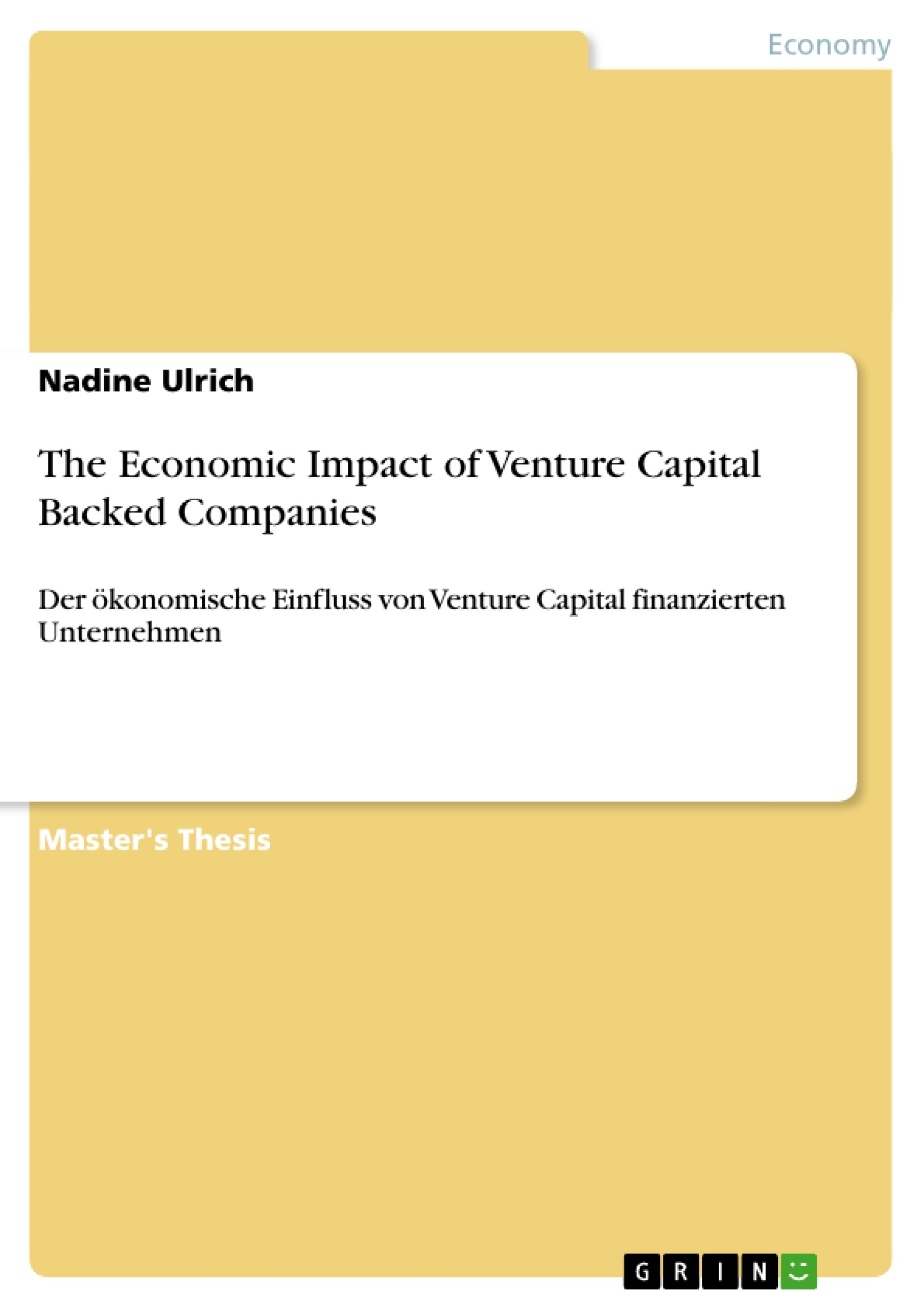Die Arbeit beschäftigt sich mit dem ökonomischen Einfluss von Venture Capital-finanzierten Unternehmen und betrachtet dabei im Detail drei Bereiche: Wachstum, Beschäftigung und Innovationen.
Outline of the work
The objective of this paper is the investigation of the economic impact of venture capital-backed companies. Therefore growth, employment and innovation are examined as the three most important spheres of influence. Beyond that, venture capital probably affects further areas of economy that are however not described within the scope of this work. This analysis should clarify the extent and kind of influence of venture-backed enterprises. It is based on various studies about the economic impact of venture capital, covering different research methods and geographic regions all over the world.
The structure of the paper is shown in Fig. 1. The first chapter introduces the topic by describing the relevance of the subject and the structure of the work. Thereafter follows a definition of venture capital, a specification of the economic focus and a discussion of methodological issues. The chapters three to five constitute the main part and investigate the above-mentioned spheres, applying a three-staged examination method. The first section describes the respective topic and discusses relevant measures for the analysis. The second section inspects the development of venture capital-backed companies by looking at quantitative and qualitative aspects. The measures identified in the first section are chosen as quantitative indicators. The qualitative research focuses on the strongest influenced areas. The last section of the respective chapter assesses the economic importance of the topic, summarises the findings and determines the role of venture capitalists. Chapter six closes with a summary of the most important results and a further outlook.
Inhaltsverzeichnis (Table of Contents)
- Introduction
- Relevance of the subject
- Outline of the work
- Fundamentals
- Venture capital
- Economic focus
- Methodological challenges in measuring the economic impact of venture capital-backed companies
- Growth in venture capital-backed companies
- Definition and measures of growth
- Development of growth in venture capital-backed companies
- Quantitative results
- Firm level
- Economy level
- Qualitative results
- Firm level
- Economy level
- Economic importance of growth and the role of venture capitalists
- Importance of corporate growth
- Importance of economic growth
- Contribution of venture capitalists to growth
- Employment in venture capital-backed companies
- Definition and measures of employment
- Development of employment in venture capital-backed companies
- Quantitative results
- Qualitative results
- Economic importance of employment and the role of venture capitalists
- Employment as an important resource of economy
- Contribution of venture capitalists to employment
- Innovation in venture capital-backed companies
- Definition and measures of innovation
- Development of innovation in venture capital-backed companies
- Quantitative results
- Qualitative results
- Economic importance of innovation and the role of venture capitalists
- Importance of innovation for competitiveness, employment and exports
- Importance of small firms for innovation
- Contribution of venture capitalists to innovation
- Summary and further outlook
Zielsetzung und Themenschwerpunkte (Objectives and Key Themes)
This master thesis explores the economic impact of venture capital-backed companies, focusing on their contributions to growth, employment, and innovation. The research aims to understand the role of venture capitalists in driving these key economic factors.- The relationship between venture capital financing and company growth
- The impact of venture capital on employment levels and dynamics
- The influence of venture capital on innovation and technological advancements
- The economic significance of venture capital-backed companies in various sectors
- The methodologies and challenges in measuring the economic impact of venture capital-backed companies
Zusammenfassung der Kapitel (Chapter Summaries)
- The introduction lays out the relevance of the subject and provides an outline of the research. The thesis aims to analyze the economic impact of venture capital-backed companies, specifically their contributions to growth, employment, and innovation.
- The "Fundamentals" chapter delves into the nature of venture capital and its economic focus, outlining key definitions and concepts. It also addresses the methodological challenges involved in measuring the economic impact of venture capital-backed companies.
- The chapter on "Growth in venture capital-backed companies" examines quantitative and qualitative data to understand the growth trajectories of these companies. It analyzes firm-level and economy-level growth, exploring the role of venture capitalists in promoting company expansion.
- The "Employment in venture capital-backed companies" chapter analyzes the impact of venture capital on employment patterns and dynamics. It examines both quantitative and qualitative data, exploring the contribution of venture capitalists to job creation and the economic importance of employment.
- The final chapter focusing on "Innovation in venture capital-backed companies" delves into the relationship between venture capital and innovation. It explores the definition and measurement of innovation, analyzes quantitative and qualitative data, and examines the contribution of venture capitalists to innovation and its economic significance.
Schlüsselwörter (Keywords)
The main keywords and focus topics of this thesis revolve around the economic impact of venture capital-backed companies, their contributions to growth, employment, and innovation, and the role of venture capitalists in these processes. Key terms include venture capital, economic impact, growth, employment, innovation, firm level, economy level, quantitative analysis, qualitative analysis, and methodological challenges.- Arbeit zitieren
- Nadine Ulrich (Autor:in), 2007, The Economic Impact of Venture Capital Backed Companies, München, GRIN Verlag, https://www.grin.com/document/135151



